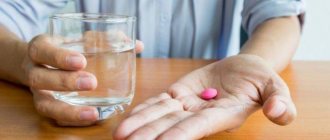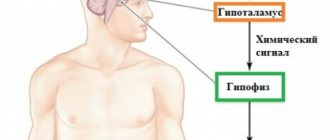What it is?
A fat-like substance called cholesterol is present in the human body in the form of 2 fractions - “good” high-density lipoproteins and “bad” low-density lipoproteins. Each part has its own functions. The first is involved in the metabolism of fats, proteins, and carbohydrates. “Bad” ones make up the cell membrane and are involved in the production of sex hormones and cortisol. The second type also takes part in the metabolism of vitamins and forms the mother’s placenta during pregnancy. This substance is required for the development of the brain of children.
“Bad” lipoproteins with high levels in the blood are deposited inside the vessels in the form of plaques. This leads to the gradual formation of atherosclerosis, which causes heart and vascular diseases to develop. With atherosclerosis, a narrowing of blood vessels appears, which is manifested by their blockage - partial or complete. With partial overlap, ischemic disease appears.
When the blood circulation of the heart and brain is impaired, atherosclerosis affects the functioning of all organs. When the blood vessels are completely blocked, a heart attack or stroke develops. Atherosclerosis occurs when there is an imbalance between 2 types of cholesterol. When assessing total cholesterol, triglyceride levels are taken into account.
Normal blood cholesterol levels in a child (table by age)
So, it’s logical to start by finding out: what level of cholesterol in the blood of children is considered normal? And not only in terms of general indicators, but also in terms of its factions – “good” and “bad”? How much should there be low-density lipoproteins (LDL), which clog blood vessels, and high-density lipoproteins (HDL), on the contrary, cleansing them?
According to the table (presented below) from the EAS (European Atherosclerosis Society), most likely, you will immediately notice that the cholesterol level fluctuates slightly over the child’s years. It is also slightly different for boys and girls. Moreover, in childhood (up to 8-10 years old) it will always be higher in boys. And in adolescence (after 10-12 years), on the contrary - for girls. This is normal and is due to puberty (i.e. puberty).
| Age: | Floor: | General (OH) | LDL | HDL |
| in newborn babies | 1.38 – 3.60 | |||
| from 3 months to 2 years | 1.81 – 4.53 | |||
| from 2 to 5 years | boys | 2.95 – 5.25 | ||
| girls | 2.90 – 5.18 | |||
| 5 — 10 | boys | 3.13 – 5.25 | 1.63 – 3.34 | 0.98 – 1.94 |
| girls | 2.26 – 5.30 | 1.76 – 3.63 | 0.93 – 1.89 | |
| 10 — 15 | young men | 3.08 – 5.23 | 1.66 – 3.34 | 0.96 – 1.91 |
| girls | 3.21 – 5.20 | 1.76 – 3.52 | 0.96 – 1.81 | |
| 15 — 20 | young men | 2.91 – 5.10 | 1.61 – 3.37 | 0.78 – 1.63 |
| girls | 3.08 – 5.18 | 1.53 – 3.55 | 0.91 – 1.91 | |
Norm
With age, cholesterol levels increase. Diagnosis is performed from 2 years of age. The indicator happens:
- Acceptable is less than 4.4 mmol/l.
- Borderline – 4.5-5.2 mmol/l.
- High – 5.3 mmol/l and more.
If a child has high cholesterol, what does this mean? This means that its level is greater than 5.3 mmol/l. The norm can increase physiologically, which is determined by individual characteristics, nutrition, and level of physical activity. But there is also a pathological deviation from the norm when the cause is systemic ailments. Each case requires a specific treatment regimen. Deviation due to the influence of pathological factors is dangerous.
Increased level
A child's blood cholesterol may be high due to a genetic factor. In this case, there is a high probability of negative impact from other factors. High cholesterol in a child is an indicator greater than 5.3 mmol/l in a child under 12 years old and 5.5 in children aged 13 to 18 years.
If a deviation is detected, the specialist prescribes a secondary analysis and a detailed lipid profile. The concentration of high and low density lipoproteins is detected. If their increase or decrease is established, drug therapy is prescribed and lifestyle correction is performed.
Cholesterol standards in children
In children under 5 years of age, only total cholesterol levels are assessed. Deviations at this age practically do not occur. The indicator increases when the child begins to actively consume foods from the common table, and parents cease to diligently monitor their benefits and quality. With the exception of serious diseases that cause an imbalance of fat metabolism.
With each subsequent year, cholesterol levels increase. This is due to the growth of the body and the increasing needs of the body for building material. Cholesterol is involved in the synthesis of hormones and in the formation of any cell in the body. This is the most reliable source of energy. Fats are consumed after carbohydrates; their reserve is stored in the liver in a special depot. Some circulate through the blood.
The norms of various fractions of cholesterol in the blood in children by age are presented in the table below.
| Child's age by year | Total cholesterol, mol/l | LDL, mol/l | HDL, mol/l |
| 0-5 | 2,95-5,25 | — | — |
| 6-10 | 3,13-5,30 | 1,63-3,63 | 0,98-1,94 |
| 11-15 | 3,08-5,23 | 1,66-3,52 | 0,96-1,91 |
In boys and girls, the norms of fat metabolism indicators are practically the same.
Causes
Why does my child have high cholesterol? This may be related:
- With a genetic factor. It causes other reasons. When a parent is diagnosed with atherosclerosis, has had a heart attack or stroke, the child’s cholesterol may be higher than normal.
- Physical inactivity, lack of physical activity. If you ignore physical education, spend a long time at the computer and lack the desire to take part in active games, this deviation may appear.
- Obesity. The disease occurs due to physical inactivity or poor nutrition, which negatively affects metabolism.
- Diet mode. Consumption of transgenic fats in large quantities is also considered a factor in the development of high cholesterol.
Control of metabolism begins in childhood, when parents form habits, create a daily routine and instill a passion for specific foods. This affects the health and biochemical composition of the blood. Whatever the reasons for high cholesterol in a child, it is necessary to normalize it in order to improve overall well-being.
Why does cholesterol rise?
Cholesterol in children increases for the following reasons:
- For the most part, it’s poor nutrition and lifestyle. This should be understood as a violation of the food intake and consumption of harmful foods high in cholesterol. Margarine and cooking oil, which parents use for cooking, are trans fats that contribute to an increase in “bad” lipoproteins and a decrease in “good” lipoproteins.
- The cause of high cholesterol in a child may be a hereditary factor. If relatives have had a stroke, heart attack or angina, then it is possible that the child also has high cholesterol. The diseases that the parents suffered from may appear when the children grow up and reach 40–50 years of age.
- Children with diabetes or hypertension are predisposed to increased cholesterol.
- Cardiovascular disease in children is a reason to check blood cholesterol.
- Passive smoking increases cholesterol.
- Lack of physical activity.
An unbalanced diet and a sedentary lifestyle are the main reasons for the development of diseases in a child, starting with high cholesterol.
Sitting at the computer for many hours in children contributes to obesity, and this creates a risk of increased cholesterol and the development of other concomitant pathologies.
Symptoms
High cholesterol in a child cannot be detected based on subjective sensations. This deviation does not have symptoms; clinical manifestations are associated with a causative disease, which led to an increase in the component in the blood.
You can check the content of the substance by taking a blood test. In an advanced state, when cholesterol greatly exceeds the norm, this can manifest itself in the form of:
- cholesterol deposits under the skin, xanthelasma, xanthoma;
- pain in the legs after a long walk.
How to understand increased?
The danger is that it is almost impossible to notice excess cholesterol in a child’s blood in the initial stages, since external signs of high LDL appear already in an advanced form. Experts recommend regularly donating blood to check cholesterol levels for those children whose close relatives suffer from cardiovascular pathologies. To prevent heart problems in your baby, parents need to pay attention to:
- diabetes;
- blood pressure surges;
- overweight child.
Return to contents
Complications
Cholesterol in normal amounts is able to participate in digestion (a source of bile acid synthesis). It is considered a building material for sex steroid hormones. When a child’s content increases and treatment is not performed, this causes a decrease in immune defense with other negative consequences.
High cholesterol in a child causes vascular obstruction. Plaques appear on their walls, the outflow of blood becomes more difficult, and in older age this can lead to atherosclerosis. If there is no treatment, lipid metabolism disorders occur in adulthood. Complications affect the cardiovascular system, gastrointestinal tract, endocrine glands and central nervous system.
Diagnostics
A blood test can determine whether a child’s total cholesterol is elevated or not. The doctor collects an anamnesis of life and concomitant diseases, taking into account the past illnesses of the parents. The first analysis is performed after 2 years, and if the level is normal, a secondary diagnosis is carried out after 1-3 years. At the request of the parents, the procedure is performed at any time.
It is necessary to take an analysis:
- with excess weight, obesity;
- diabetes mellitus;
- unfavorable family history;
- irregular diet, frequent consumption of fatty foods;
- physical inactivity, lack of physical activity;
- deterioration of health;
- decreased appetite, diseases of the gastrointestinal tract.
Diagnostics allows you to detect cholesterol levels. If there is a deviation from the norm, the doctor will prescribe appropriate treatment. You must follow all recommendations provided by a specialist.
Diagnostics – tests for cholesterol levels in children
Now we will touch on two important questions: how can you determine the level of cholesterol in the blood of a child or teenager, and when should this be done?
Recommended diagnostic time frames – when should tests be taken?
According to the recommendations of the AAP (American Academy of Pediatrics), in order to prevent cardiovascular and other dangerous diseases, children should be diagnosed (screened) for cholesterol levels between the ages of 8 and 11 years. And again, at an older age - from 17 to 21 years.
However, in some cases, a serious examination of even 2-year-old children may be required. For example, if the child’s mother or father (as well as his grandmother or grandfather) faced such “problems” as:
- dyslipidemia (violation of the ratio of blood lipids (HDL / LDL / VLDL) and (tg) triglycerides
, contributing to the development of atherosclerosis); - or premature cardiovascular disease (for men under 55 years of age, for women under 65 years of age);
Other, no less important factors (more related to the child himself):
- diabetes;
- hypertension (high blood pressure from 140/90 mm Hg and above)
- overweight, obesity (just keep in mind that BMI / i.e. Body Mass Index
is not used for children); - and PASSIVE smoking (when children often “breathe” the smoke of their parents’ cigarettes).
Diagnostic methods - what are the types of children's tests?
Children's cholesterol screening is almost no different from an adult's. In order to determine total cholesterol (TC) levels, it is enough to have your child’s blood tested (at a clinic) (from a finger prick) or use a home device. For example, the modern DUO model of a glucometer, which perfectly measures both blood sugar levels and cholesterol levels. At least once every 3 years - this must be done! Even with good health.
If the indicators (TC) are high, doctors can prescribe (by the way, both you and the child) a more extensive blood test (from a vein), called a LIPIDOGRAM
.
In order to accurately determine the concentration level of all cholesterol fractions (lipoproteins: HDL, LDL, VLDL), Triglycerides. And also calculate the KA (atherogenic coefficient)
, which allows you to identify the risks of developing atherogenic CVDs.
That is, Cardiovascular Diseases (atherosclerotic origin / in simple words - origin). By the way, on our website there is a special online calculator
for calculating it.
A few weeks before the lipid profile (both you and your children) need to follow a “low-fat diet”, and 12 hours before the screening - completely abstain from food! This blood test is taken only on an empty stomach.
Treatment
If a child is 10 years old, younger or older, has high cholesterol, complex treatment is prescribed, which includes following a diet and taking medications (statins, fibrates). Normalization is achieved with a change in lifestyle. The child will need to spend time more actively, play outdoor games and do exercises.
Medicines are prescribed based on the underlying disease. If control of the component content can be achieved through diet and physical activity, medications are not prescribed. To normalize the level of fats in the blood, you need to:
- avoid passive smoking;
- exercise daily;
- consume foods with fiber;
- eat less sugar;
- restore daily routine, healthy sleep.
Drug treatment
Pharmacological intervention is prescribed for children aged 10 years and older in the case of:
- elevated LDL concentration ≥ 190 mg/dl (or ≥4.9 mmol/l);
- or ≥ 160 mg/dL (or ≥4.1 mmol/L) with a family history of early onset cardiovascular disease (or the presence of 2 or more additional risk factors);
- or LDL blood levels ≥130 mg/dL (or ≥3.36 mmol/L) in diabetes mellitus.
According to the most recent studies (conducted by the BHF - British Heart Foundation), published in January 2020, the use of statins is safe for children! The recommended age for starting to take these medications (if diet or other non-pharmacological treatments are ineffective) is after 10 years. With the exception of Pravastatin, which can be used in particularly difficult cases of hereditary hypercholesterolemia - even after 8 years.
source
Nutrition
Nutrition is important:
- It is necessary to limit foods containing trans fatty acids and saturated fats.
- It is necessary to reduce the consumption of sugar and refined, “fast” carbohydrates.
- The diet should include fish, white meat, and whole grain bread.
- Vegetable oils should be used instead of solid fats.
Fats should be consumed in moderation, not completely eliminated. Plant foods are healthy - fruits, vegetables, grains that do not contain cholesterol. But there is a lot of it in animal products.
Ways to reduce high cholesterol in a child
Medicines are prescribed only in extreme cases. If the reason for the increase in cholesterol is not the presence of severe, concomitant diseases, then lifestyle and diet modifications are sufficient. Within 1-2 months the indicator will return to normal.
Diet
The basic principle of the diet is the refusal to consume animal fats and the inclusion of vegetable fats in the diet.
It is necessary to avoid the following dishes and products:
Vegetables and fruits that help normalize cholesterol levels.
Recommended cooking methods: boiling, stewing, baking in the oven, steaming.
Animal fats are replaced by vegetable ones: oils (olive, sesame, nut, flaxseed), fruits (avocado), nuts. These products contain essential polyunsaturated fatty acids (PUFAs): omega-3, 6, 9. They dissolve fatty plaques and at the same time replenish the body's lack of fat molecules.
Omega is also found in fish oil. Actively offer your child fatty fish: salmon, trout, herring, mackerel. It is recommended to consume it in the form of soup. All the beneficial substances are boiled into the broth. It becomes a storehouse of PFA.
It is advisable to eat food in small portions, 5-6 times a day. Don't forget about snacks. This could be a glass of low-fat yogurt or a fruit salad with flaxseed oil and nuts.
Physical activity
If no cardiovascular pathologies have been detected, then any sport will do. There is no need to do it until you become overtired; 2-3 workouts per week with moderate physical activity are necessary. Make sure your child walks a lot (at least 2-3 hours a day). Fresh air saturates the blood with oxygen. It promotes the resorption of atherosclerotic plaques.
Physical activity is essential to improve blood flow. Intensive blood supply to body tissues prevents the formation of stagnation and resolves previously appeared ones.
Physical exercise
The best method to increase the high-density lipoproteins that the body needs is exercise. At least 20-30 minutes of exercise 3 times a week will be enough. It is important that there is a load on different muscle groups in the legs and the heartbeat increases. The following activities are excellent physical activity for children:
- a ride on the bicycle;
- roller skating;
- long walks in nature;
- jumping rope;
- ball games.
You need to spend as little time as possible watching TV and gadgets. Obese children typically have low HDL levels and high LDL levels. When your weight normalizes, cholesterol reaches the desired level.
How to treat children with high cholesterol?
The best way to treat hyperlipidemia in children is to avoid junk food and exercise, in which the whole family should participate. In general, a child's body is more flexible than an adult's to rebuild it towards health without drugs.
Where adults are usually prescribed statins, which must be taken for the rest of their lives, children only need a healthy diet and activity.
Limit fatty foods, especially those containing saturated and trans fats. The total amount of fat consumed by a child should be no more than 30% of the total daily calories. However, this rule does NOT apply to children under 2 years of age. The amount of saturated fat should be approximately 10% of the daily diet. Trans fats should be avoided completely. For children in a high risk group (grade 1 and 2 obesity), saturated fat should be even less - about 5%.
The diet should be varied and balanced. In other words, it should contain fruits, vegetables, meat and seafood in various combinations;
Create a daily routine that includes at least an hour of physical activity. Regular aerobic exercise: cycling, running, outdoor play, walking in the park, etc. helps raise HDL (“good” cholesterol) levels and reduce the risk of cardiovascular disease.
Here is an example of a healthy daily diet for your child.
For breakfast:
Fruit, oatmeal or low-fat yogurt (no sugar!). Use skim or one percent milk instead of whole milk when cooking;
For lunch and dinner:
Baked in the oven, stewed or boiled. Soup, roast chicken or beef, fish or steamed lean cutlets. Also add whole grains, cereals (buckwheat, pearl barley, rice) and legumes (peas, beans) to your diet. Also, nutritionists do not recommend eating chicken eggs for people who suffer from high cholesterol. Although they do not pose a threat to healthy people;
Statins
These drugs are prescribed to children very rarely, only in the presence of those forms of high cholesterol that appear from a genetic disease, and not due to diet or poor lifestyle.
If cholesterol does not decrease after restoring the diet and adjusting the lifestyle, then special diets are prescribed after consultation with a specialist. There are also special workouts that eliminate excess cholesterol. But in difficult cases, after consultation with a doctor, statins can be used. It is necessary to adhere to the treatment prescribed by a specialist. After 2-4 months, an examination is performed to determine the composition of lipids in the blood. This will allow you to evaluate the result of therapy.
Primary prevention of complications involves maintaining a normal weight and following the principles of a healthy lifestyle. If a child has high cholesterol, medications may be prescribed to normalize this substance, including statins - Pravachol. This medication can be used in treatment for genetic predisposition. Usually, if you follow the recommendations of a specialist, your cholesterol level becomes normal.











